35:1–19 This narrative dates from the time of Jehoiakim (reigned 609–598 bc) and is not chronologically sequential with the preceding narrative from the time of Zedekiah and the siege of Jerusalem (587 bc). The narrative probably is placed here intentionally, following the depiction of Jerusalem’s unfaithfulness in 34:8–22, in order to draw an explicit contrast between the faithfulness of the sect of Rechabites (or Rekabites) and the unfaithfulness of the leaders of Judah. |
35:1 Jehoiakim See note on 22:18.
35:2 the Rechabites A nomadic tribe apparently related to the Kenites (1 Chr 2:55) and descended from Jonadab (Jehonadab), son of Rechab (2 Kgs 10:15).
35:3 Jaazaniah Probably mentioned by name because he was the current head of the clan.
35:4 the chamber of the officials Priestly families and royal officials had rooms in the temple complex where they may have conducted business or shared sacrificial meals.
Maaseiah Perhaps the father of Zephaniah, the priest mentioned in Jer 21:1.
the keeper of the threshold A priestly office responsible for overseeing the collection of temple taxes and guarding the entrances to the temple (see 52:24; 2 Kgs 12:9; 22:4; 23:4; 25:18).
35:5 Drink wine Jeremiah sets out wine before the Rechabites, knowing they will not drink it. The action takes place in the temple chambers, providing a public audience for Jeremiah’s contrasting examples of covenant loyalty.
35:6 We will not drink wine The Rechabites refuse and offer a detailed explanation of the prohibitions passed on to the family by their ancestor, Jonadab.
Jonadab See 2 Kgs 10:15–23. He actively supported Jehu’s purge of the supporters of Baal, suggesting that he may have been a committed follower of Yahweh.
35:7 you shall not build a house Jonadab’s rules required abstaining from alcohol, agriculture, and permanent housing. The purpose behind these rules is unclear, but Jeremiah is concerned not with why the Rechabites obey—simply that they do. The clan has kept these rules for a period of at least 200 years. The story of Jehu’s rebellion, in which Jonadab plays a minor part, takes place around 840 bc.
35:11 before the army of the Chaldeans The Rechabites explain the apparent inconsistency in their current city life by noting it was a temporary response to the invasion. Nebuchadnezzar, along with vassals from Syrian city-states, conducted military campaigns in Syria-Palestine in 605, 601, and 598 bc.
35:14 they have obeyed the command of their ancestor The example of the Rechabites is held up for Judah to follow. They obeyed their father’s command, so Judah should obey Yahweh.
and you have not listened to me Judah’s persistent failure to repent, despite frequent appeals from the prophets, will lead to disaster.
35:19 to stand before me The Hebrew expression here signifies worshiping in Yahweh’s presence in the temple. It indicates that the family will have an enduring legacy of faithful people worshiping Yahweh. Despite the coming judgment, a remnant will be preserved from the Rechabites.

|
About Faithlife Study BibleFaithlife Study Bible (FSB) is your guide to the ancient world of the Old and New Testaments, with study notes and articles that draw from a wide range of academic research. FSB helps you learn how to think about interpretation methods and issues so that you can gain a deeper understanding of the text. |
| Copyright |
Copyright 2012 Logos Bible Software. |
| Support Info | fsb |
 Loading…
Loading…



 was based on the business of chariot-making.
was based on the business of chariot-making.